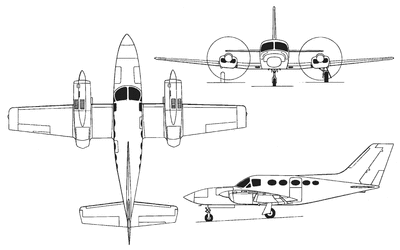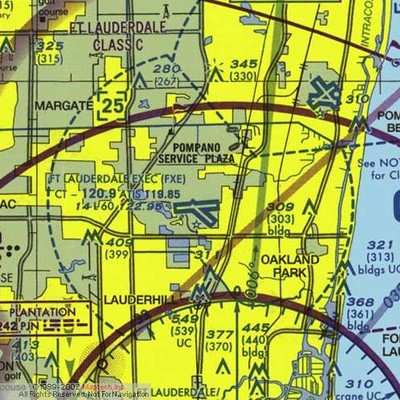Pilot Appeared To Be Troubleshooting Engine Issues Before
Flight
 A Cessna 421 that went down off the
end of a Ft. Lauderdale Executive Airport runway was definitely
having some engine issues prior to takeoff. The Preliminary NTSB
reported that the pilot "appeared to be troubleshooting an engine
issue" prior to the accident that brought the plane down and took
the life of the pilot and sole occupant of the aircraft.
A Cessna 421 that went down off the
end of a Ft. Lauderdale Executive Airport runway was definitely
having some engine issues prior to takeoff. The Preliminary NTSB
reported that the pilot "appeared to be troubleshooting an engine
issue" prior to the accident that brought the plane down and took
the life of the pilot and sole occupant of the aircraft.
"Shortly after it got in the air, it did report trouble to the
tower," FXE spokesman Chaz Adams told TransWorld News. "The tower
cleared it to come back and land. In trying to make it back,
that’s when it went down."
"We saw the plane turn sideways, and then it just nosedived,"
said witness Eddie Mujica, who works at a business north of the
accident site. "It's not something you see every day."
NTSB Identification: ERA09FA248
14 CFR Part 91: General Aviation
Accident occurred Friday, April 17, 2009 in Oakland Park, FL
Aircraft: CESSNA 421B, registration: N1935G
Injuries: 1 Fatal.
This is preliminary information, subject to change, and may
contain errors. Any errors in this report will be corrected when
the final report has been completed.
On April 17, 2009, about 1115 eastern daylight time, a Cessna
421B, N1935G, owned and operated by the commercial pilot, was
substantially damaged during impact with a residence in Oakland
Park, Florida, following a loss of engine power shortly after
takeoff from Fort Lauderdale Executive Airport (FXE), Fort
Lauderdale, Florida. The certificated commercial pilot was killed.
The personal flight was conducted under the provisions of 14 Code
of Federal Regulations Part 91. Visual meteorological conditions
prevailed and an instrument flight rules (IFR) flight plan was
filed for the planned flight to Fernandina Beach Municipal Airport
(55J), Fernandina Beach, Florida.

According to a friend of the pilot, who had also flown the
accident airplane on many occasions, the airplane was based in
Costa Rica. The pilot lived in Costa Rica, but spent 2 or 3 weeks
every year in the Fort Lauderdale area. Prior to the accident
flight, the pilot flew the airplane from Costa Rica to FXE, where
it sat for 2 days. During that time, the airplane was fueled with
approximately 75 gallons of 100 low lead aviation gasoline. The
pilot intended to sell the airplane to a buyer in the Jacksonville
area, and was flying to 55J.
Witnesses at a fixed based operator (FBO), located at FXE,
reported that the pilot ran the engines to full power for about 20
minutes while the airplane sat on the ramp. The pilot appeared to
be troubleshooting an engine issue. The pilot then shut down the
engines, added oil to one of the engines (not sure which one), and
started them again. He then ran the engines for 5 more minutes,
before departing on runway 8. Witnesses then observed fire
emanating from the right engine after rotation.
Several witnesses near the accident site observed the airplane
in a shallow climb from runway 8, flying low, with the right engine
on fire. Some of the witnesses reported that the flames were yellow
in color and no smoke was observed. The airplane then banked right
and descended into a residential area.
Review of preliminary data from Federal Aviation Administration
(FAA) revealed that the pilot radioed the FXE tower shortly after
departure. The pilot stated that he was having trouble with the
airplane and needed to return to the airport. The tower controller
cleared the flight to land on any runway, and no further
communications were received from the accident airplane.

The wreckage was located in a residence, and examined on April
17 and 18. All major components of the airplane were accounted for
at the scene. A debris path originated at the rear of the
residence, where freshly cut tree branches were observed. The
branches were cut at an approximate 45-degree angle, and exhibited
black paint transfer. The debris path extended on an approximate
280-degree magnetic heading to the front of the residence. The
airplane came to rest inverted on a heading about 060 degrees
magnetic. The right engine and portions of the right wing were
located at the rear of the residence. The left engine, portions of
the left wing, the empennage, and the cockpit area were located at
the front of the residence. The majority of wreckage had been
consumed by a postcrash fire.
Rudder control continuity was confirmed from the rudder pedals
to the rudder, with cable cuts performed by emergency medical
services (EMS) noted. Rudder trim continuity was confirmed from the
trim wheel to the rudder tab, and measurement of the rudder trim
actuator revealed an approximate 2-degree tab left (rudder right)
position. Elevator control continuity was confirmed from the
cockpit area to the elevator horn, with some turnbuckle melting and
EMS cable cuts noted. Elevator trim continuity was confirmed and
measurement of the elevator trim actuator revealed an approximate
neutral setting. Left aileron control cable continuity and trim was
confirmed from the control yoke to the left aileron bellcrank, with
melting of several aluminum components noted. Measurement of the
aileron trim actuator revealed an approximate 15-degree left
aileron tab down (aileron up) position. Right aileron control
continuity was confirmed from the control yoke to the right wing
root, where the cable had separated consistent with overstress, and
continued on to the right aileron bellcrank.
The airplane's landing gear was observed in the retracted
position and the position of the flaps could not be determined. The
right fuel selector was positioned to the right main fuel tank and
the left fuel selector was not located. Several flight instruments
were recovered from the cockpit and although they sustained fire
damage, some were readable. Both attitude indicators were tumbled
left wing low. An airspeed indicator displayed approximately 110
knots. A turn and bank indicator's needle was near the centered
position and the ball was destroyed.
Both propellers had separated from their respective engines. The
engines, turbochargers, and propellers were retained for further
examination.
The pilot, age 80, held a commercial pilot certificate, with
ratings for airplane multiengine land and instrument airplane. He
held a private pilot certificate, with ratings for airplane
single-engine land, airplane single-engine sea, and glider. His
most recent FAA second-class medical certificate was issued on
December 18, 2007. At that time, the pilot reported a total flight
experience of 23,000 hours. The pilot's wife reported that he had
approximately 5,000 hours of flight experience in the accident
airplane, and he had flown about 25 hours during the 90-day period
preceding the accident.
The six-seat, low-wing, retractable-gear airplane, serial number
421B-0836, was manufactured in 1974. It was powered by two
Continental GTSIO 520-H, 375-horsepower engines, equipped with
McCauley propellers. Maintenance logbooks were located in the
airplane, and had been partially consumed by fire. Review of the
logbooks revealed that the airplane's most recent annual inspection
was completed on June 6, 2008.
The reported weather at FXE, at 1053, was: wind from 060 degrees
at 17 knots; visibility 10 miles; scattered clouds at 3,300 and
4,500 feet; temperature 24 degrees Celsius; dew point 16 degrees
Celsius; altimeter 30.17 inches of mercury.
 Classic Aero-TV: The Switchblade Flying Car FLIES!
Classic Aero-TV: The Switchblade Flying Car FLIES! ANN FAQ: Q&A 101
ANN FAQ: Q&A 101 ANN's Daily Aero-Term (04.12.24): Discrete Code
ANN's Daily Aero-Term (04.12.24): Discrete Code ANN's Daily Aero-Term (04.13.24): Beyond Visual Line Of Sight (BVLOS)
ANN's Daily Aero-Term (04.13.24): Beyond Visual Line Of Sight (BVLOS) ANN's Daily Aero-Linx (04.13.24)
ANN's Daily Aero-Linx (04.13.24)





